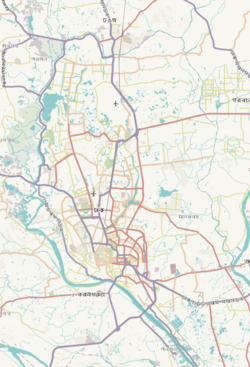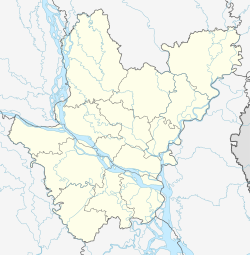Chowkbazar
চকবাজার | |
|---|---|
 Expandable map of vicinity of Chowkbazar Thana | |
| Coordinates: 23°43′01″N 90°23′47″E / 23.717036°N 90.396322°E | |
| Country | |
| Division | Dhaka Division |
| District | Dhaka District |
| Area | |
• Total | 2.07 km2 (0.80 sq mi) |
| Population (2022)[1] | |
• Total | 123,053 |
| • Density | 75,433/km2 (195,370/sq mi) |
| Time zone | UTC+6 (BST) |
| Postal code | 1211 |
| Area code | 02[2] |
Chowkbazar (Bengali: চকবাজার), also called Chawkbazar Model Thana, is a Thana of Dhaka District in the Division of Dhaka, Bangladesh. It was formed in August 2009 from parts of Lalbagh Thana and Kotwali Thana, and has an area of 2.07 km2.[3] It includes the Chowk Bazaar and was the site of the February 2019 Dhaka fire.
History
[edit]
Chowkbazar (also spelled, Chawk Bazaar) is known as a sprawling market area in Dhaka, Bangladesh, with hundreds of shops, market stalls and vendors.[4][5] In 1702, Murshid Quli Khan established the market, naming it Badshahi Bazar, which was later renamed as Chawk Bazaar.[6]
Later, James Taylor in his 1840 book, "A Sketch of the Topography & Statistics of Dacca" left a description of Chowkbazar: "It is a square of pretty large dimensions, and is surrounded chiefly by mosques and shops. The open space, in which the bazar is held, is enclosed by a low wall, with a carriage road around it..."[7]
Demographics
[edit]According to the 2011 Census of Bangladesh, Chak Bazar Thana had 25,401 households with an average household size of 4.58 and a population of 156,147. Males constituted 64.69% (101,016) of the population while females 35.31% (55,131). Chak Bazar Thana had a literacy rate (age 7 and over) of 70.4%, compared to the national average of 51.8%, and a sex ratio of 183.There were 457 floating people in this jurisdiction. [9]
The religious breakdown was Muslim 97.92% (152,888), Hindu 2.00% (3,116), Christian 0.06% (96), Buddhist 0.03% (45), and others 0.00% (2). 42 ethnic people were living there.
Notable landmarks
[edit]
Beside the market square is Chawk Mosque, built by Shaista Khan in 1676. It is 94 feet long, 80 feet wide and has three domes. Other notable landmarks include: Hussaini Dalan (1642), Bara Katra (1641), Choto Katra (1663) and Dhakeshwari Temple (1890).[3]
See also
[edit]References
[edit]- ^ National Report (PDF). Population and Housing Census 2022. Vol. 1. Dhaka: Bangladesh Bureau of Statistics. November 2023. p. 386. ISBN 978-9844752016.
- ^ "Bangladesh Area Code". China: Chahaoba.com. 18 October 2024.
- ^ a b Lilyma Ahmed (2012). "Chawkbazar Model Thana". In Sirajul Islam and Ahmed A. Jamal (ed.). Banglapedia: National Encyclopedia of Bangladesh (Second ed.). Asiatic Society of Bangladesh.
- ^ "Chawk Bazar, the heart of the old city". Dhaka Calling: A Monthly Tourist Guide. Archived from the original on 21 November 2013. Retrieved 7 April 2023.
- ^ Mould, David (13 June 2019). "Spotlight on Bangladesh: Exploring Old Dhaka". Newsweek. Retrieved 7 April 2023.
- ^ Mamoon, M. (2017). ঢাকা : স্মৃতি বিস্মৃতির নগরী. Vol. 1. Anannya. ISBN 9849055839.
- ^ "Chawk Bazar of the olden times". The Daily Star. 2023-12-14. Retrieved 2024-01-02.
- ^ "Bangladesh Population and Housing Census 2011 Zila Report – Dhaka" (PDF). bbs.gov.bd. Bangladesh Bureau of Statistics.
- ^ "Community Tables: Dhaka district" (PDF). bbs.gov.bd. 2011.
- ^ MA Bari (2012). "Chawk Mosque, Dhaka". In Sirajul Islam and Ahmed A. Jamal (ed.). Banglapedia: National Encyclopedia of Bangladesh (Second ed.). Asiatic Society of Bangladesh.


